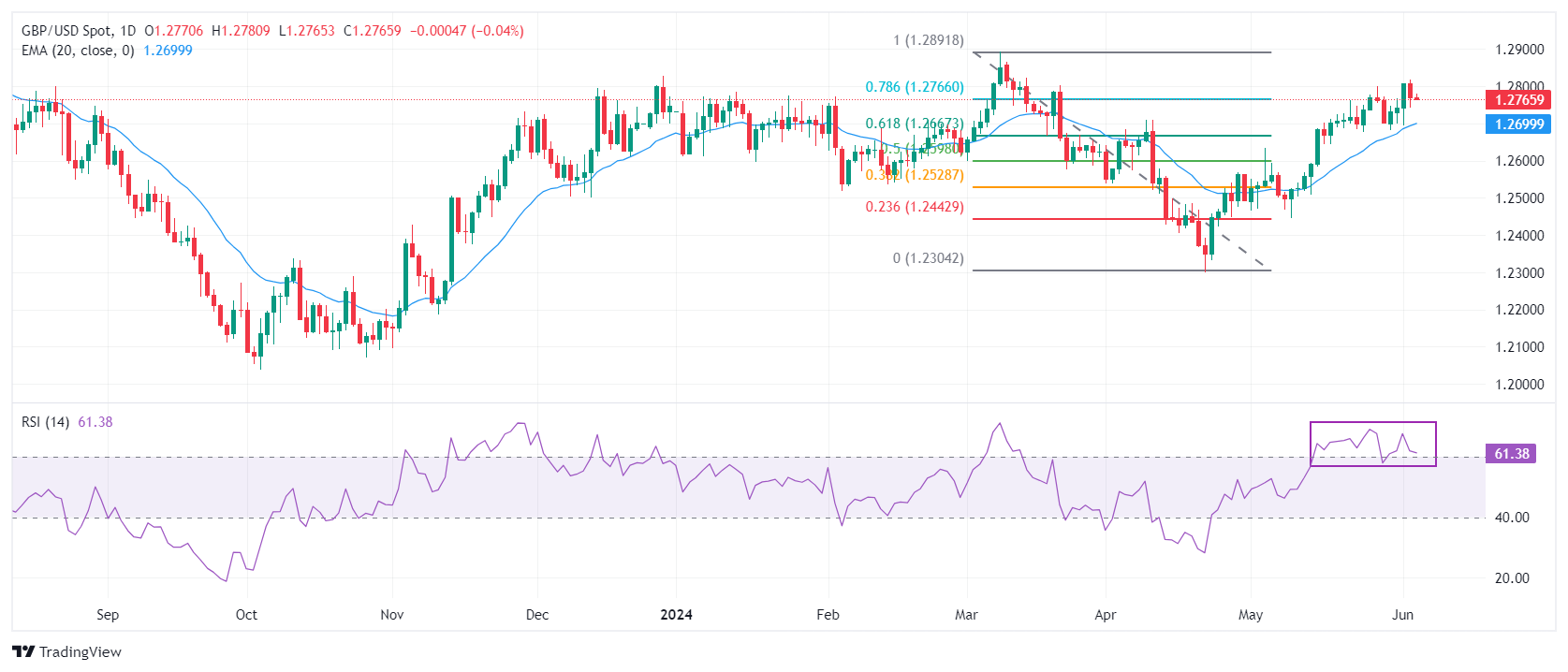- Pound Sterling Falls Against US Dollar Following Strong US Services PMI Report
- Market speculation about the Fed’s interest rate reduction in September is strengthening.
- The BoE is expected to make two rate cuts this year.
The British Pound (GBP) falls from 1.2800 against the US Dollar (USD) in the American session on Wednesday. The GBP/USD pair comes under pressure as the US Dollar extends its recovery following the release of US Institute for Supply Management (ISM) Services Purchasing Managers’ Index (PMI) data. ) for May, which were stronger than expected.
The ISM Services PMI, which measures activity in the services sector that represents two-thirds of the economy, returns to expansion at a faster than expected pace. The PMI rose to 53.8, from estimates of 50.5 and the previous reading of 49.4. In addition to the services PMI figures, another subcomponent such as the new orders index, which reflects demand prospects, jumped to 54.1 from the previous reading of 52.2.
The US Dollar Index (DXY), which tracks the value of the Dollar against six major currencies, rises to 104.40. However, the short-term outlook for the US dollar remains uncertain amid growing speculation that the US Federal Reserve (Fed) will begin cutting interest rates at its September meeting.
According to the CME FedWatch tool, 30-day Fed Funds futures price data suggests a 65% chance that interest rates will decline from their current levels in September. The probability has increased significantly from the 47% recorded a week ago. The weak US ISM Manufacturing PMI report for May and downwardly revised first-quarter Gross Domestic Product (GDP) data have boosted Fed rate cut bets for September.
Daily Market Summary: British Pound Falls as US Dollar Rebounds
- British Pound falls from 1.2800 against the US Dollar following strong US ISM Services PMI data. GBP/USD falls following US Dollar recovery. However, the near-term outlook remains uncertain, as the main event this week will be the May Non-Farm Payrolls (NFP) data, due out on Friday. Labor market data will provide new clues on the outlook for interest rates.
- Meanwhile, recent employment indicators suggest that the US labor market is normalizing. The US Automatic Data Processing (ADP) agency showed new private payrolls were 152,000 in May, below estimates of 173,000 and the previous reading of 188,000 in April, revised down from 192,000. Additionally, US Job Openings and Labor Turnover (JOLTS) data for April showed that job openings were lower, at 8.06 million versus expectations of 8.34 million and the previous reading of 8.35 million.
- The UK economic calendar lacks top-tier events this week. Therefore, potential moves in the GBP/USD pair will be guided by the US Dollar, which is expected to remain active due to a data-packed week in the US. In the UK region, investors are looking for fresh clues on when the Bank of England (BoE) will start reducing interest rates. Financial markets currently expect the BoE to make two rate cuts this year and choose the August meeting as the earliest point to begin the policy normalization process.
Technical Analysis: British Pound Trading Near 78.6% Fibonacci Retracement
The British pound is trading within Tuesday’s trading range, suggesting indecision among market participants. The GBP/USD pair struggles to stay above the 78.6% Fibonacci retracement support (traced from the March 8 high of 1.2900 to the April 22 low of 1.2300) at 1.2770.
The Pound is expected to remain bullish as the 20-day EMA at 1.2700 is tilted higher, indicating a strong bullish trend.
The 14-period RSI has moved into the 40.00-60.00 range, suggesting that momentum has shifted to the upside.
Economic Indicator
ISM Services PMI
He Institute for Supply Management (ISM) Services Purchasing Managers Index (PMI), published monthly, is a leading indicator that measures business activity in the US services sector, which makes up the majority of the economy. The indicator is derived from a survey of supply executives across the US based on information they have collected within their respective organizations. Survey responses reflect the change, if any, in the current month compared to the previous month. A reading above 50 indicates that the service economy is generally expanding, a bullish sign for the US Dollar (USD). A reading below 50 signals that service sector activity is generally in decline, which is considered bearish for the USD.
Why is it important for traders?
The Services Purchasing Managers Index (PMI) from the Institute for Supply Management (ISM) reveals current conditions in the US services sector, which has historically been a large contributor to GDP. A reading above 50 shows expansion in economic activity in the service sector. Stronger than expected readings generally help the USD strengthen against its rivals. In addition to the main PMI, the Employment Index and Prices Paid Index numbers are also closely watched by investors as they provide useful information on the state of the labor market and inflation.
Source: Fx Street
I am Joshua Winder, a senior-level journalist and editor at World Stock Market. I specialize in covering news related to the stock market and economic trends. With more than 8 years of experience in this field, I have become an expert in financial reporting.








